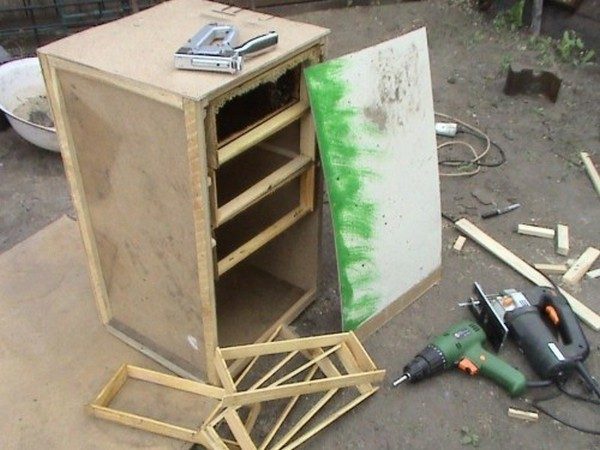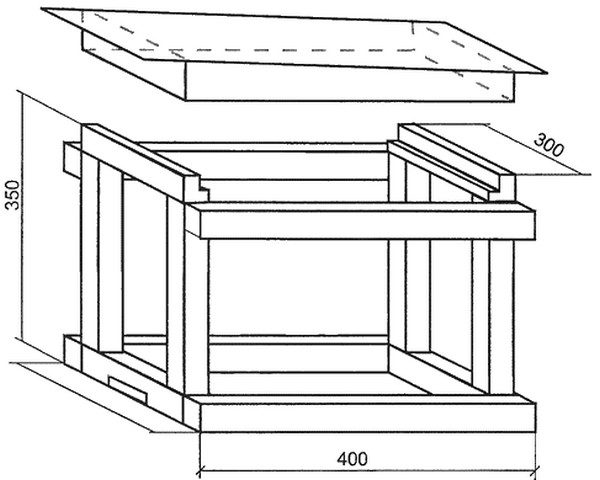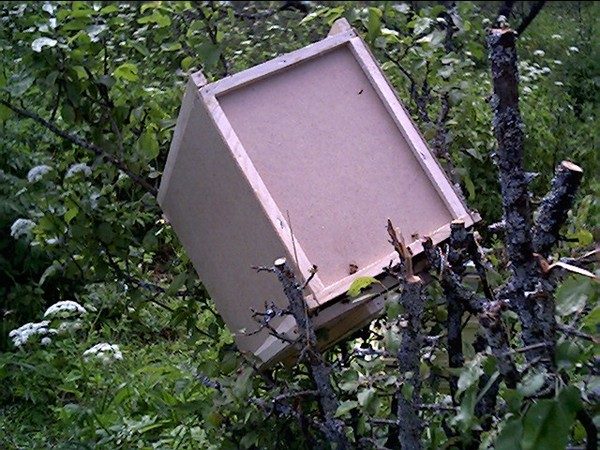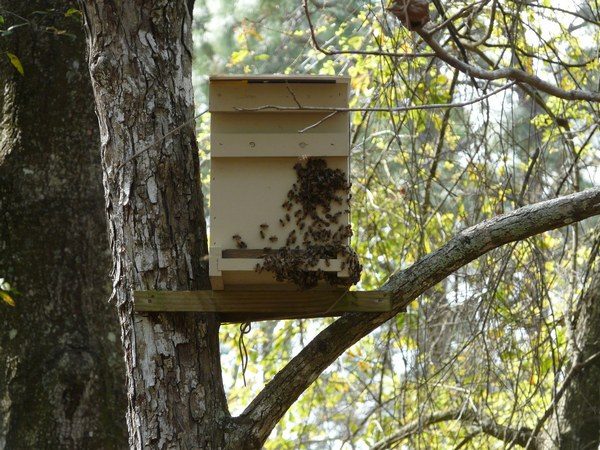While swarming, the uterus with its bee family is looking for a new home. Then there comes a time when some beekeepers lose their bees, while others replenish the apiary. Multiply the number of honey insects in the apiary will help special devices - bee traps. Knowledgeable beekeepers often construct them themselves from scrap materials, using drawings.
In this article we will explain how to make a trap for bees with your own hands according to the drawings, how to make a trap out of plywood and a bottle.
Table of contents
Why put traps
When a bee colony, with a womb over two years old, is not busy with work (honey collection), they begin to prepare for swarming. Such a process is natural and instinctive, and the beekeepers, in turn, must resort to many tricks. If you do not notice this action, then the bee colony begins to swarm.
Roy can fly from a neighboring or from an unsupervised apiary, and can fly many kilometers in search of suitable housing. - this is a wandering swarm. Beekeepers value these bees for quality performance, for catching these families and setting traps.
It is at such moments that a hand made swarm trap is needed.
What a bee trap looks like
The classic catcher is a bee trap made of plywood or fiberboard, which:
- has a bolt, it can be used to easily and tightly close the bees in the trap when it is time to transport;
- You can make yourself, or find a suitable farm;
- fits frame, a couple of them with honeycombs for bait;
- equipped with only one tapintended to enter insects.
Production under the standard frame of plywood
Before installation, it is necessary to prepare the material:
- plywood (thickness 4 mm);
- wire;
- rope (10 m);
- reiki;
- piece of canvas;
- nails;
- boards (20 cm wide and 2 cm thick);
- pins (size 4 mm);
- insulating material (polyethylene or roofing material);
- glue;
- sheet foam.

Instruments:
- furniture stapler;
- drill;
- stamestka;
- hammer;
- drill;
- saw.
Body manufacturing
The technology is as follows:
- the bottom is being constructed from planks two centimeters thick;
- from the same slats, the rear and the facade of the catcher are assembled;
- a gap is cut in the front wall so that the largest bee can climb through it. In most cases, its dimensions are 10x100 mm;
- walls are attached to the bottom;
- by means of laths, lateral bases are made;
- parts for upholstery of the box are being prepared from plywood sheet;
- sheathed sides with plywood;
- on the side walls inside, the rails are attachedon which the frame hangers will fall;
- finish body assembly.
You will also be interested to know:
- What to do with a bee sting.
- How to determine the quality of honey and its naturalness.
- Useful properties of honey for men and women.
The cover design is similar to the roof of ordinary evidence. Production Example:
- a quadrilateral is drawn on a sheet of plywood so that its dimensions are 1 cm larger than the box itself;
- this part is being prepared;
- rails are nailed around the edges so that a part can be firmly seated on the base of the trap;
- the foam is processed with glue and applied to the bottom of the cover;
- the top of the part is sheathed with ruberoid or cellophane;
- the cover to the case is fixed;
- from the wire preparing the handle for the trap. It is needed to transfer the structure and hanging it on a tree.
Finishing touches:
- frames fit into the structure. One or two frames with honeycombs are placed in the front, and the next ones are with a wrinkle. The maximum number is five frames;
- they are covered with canvas;
- tap holes treated with propolis. You can use lemon balm or basil, they also attract bees.
Bee trap from fiberboard
This drawing of a catcher from DVP, contains 6 8 frames. Starting production, the necessary material is prepared:
- linseed oil;
- Hardboard;
- dark green paint;
- bars 40 mm wide and 25 mm thick.
The method of manufacturing the device with your own hands according to the drawings
The principle of manufacturing a scrubber from various materials is practically the same:
- parts for walls are cut from the finished sheet of hardboard. It is easy to make, all dimensions are shown in the drawing;
- the bend is made using rails to set the frame. Attached to the top of the facade and rear of the case, making a groove on the bars.

- For this, it is better to use a folding edge mill;
- to the front and rear wall attach the slats;
- make a slot for the entry clearance on the façade of the trap;
- side panels are attached to the front and rear wall;
- prepare a place for landing cover.
For this:
- fix the longitudinal bars on the side walls (the upper bar should be 40 mm below the edge);
- trim the roof of the rails;
- instead of ceiling boards, you can use a cut piece of hardboard;
- form the roof of the parts of the hardboard so that the back and the front have visors;
- at the end, the trap must be saturated with linseed oil. To make the design less noticeable, you can apply a layer of dark green paint.
Preparing a trap for bees is not the end. It must be safely caught and shifted to a permanent hive. To do this, remember a few tips:
- place the constructions early, because reconnaissance bees are already searching for a habitat in two or three weeks;
- periodically it is necessary to watch traps. If you notice a bee's notch (at least 15), then the family at someone's apiary or a swarm of wild bees is preparing for departure;
- you can climb a tree and listen to the hive;
- when you make sure that the family is already settled in a trap, you need to close it;
- it should be done at sunset, when all the bees are at home;
- deliver bees to the apiary;
- if necessary, return the trap back, not forgetting to rub the notch, as well as the front wall from the inside.

Bottle trap
Frequently, beekeepers resort to a different type of trap, which is needed not to catch swarms, but to destroy harmful pests. The conversation is about wasps - dirty dogs, who bring a lot of trouble to beekeepers and bees. These insects are active even in cold weather, and often penetrate bee houses to steal honey.
The beekeeper is obliged to monitor this, otherwise the consequences can be flying for many hive. That is why the bee trap is made from a bottle. The dimensions of such a trap are small, but it also does the necessary work.
For its manufacture does not need special drawings and materials. Must have:
- plastic container;
- scotch or wire;
- awl;
- knife.
Making a trap is easy. Cut off the top of the bottle and put back neck down. Inside the bait is placed, and the device is fixed in the appropriate place. The principle of capture is as follows: the wasp enters the trap through a funnel, but does not find the exit, constantly stumbles upon a modified cone.

Drones trap
You can also make a trap for drones with your own hands. The device is made of wire. It consists of two sections, between which they mount a barrier that has 2 ends of a fine mesh. In front set the dividing grid. Drones will not be able to pass through the lattice and fall into the upper grid, not being able to get out of there. It is a trap.
There they can gather up to one liter. Soon all perish and must be thrown away. In case of continuing swarming, the trap is re-installed. If the uterus is caught, you need to hang the structure and wait until the bees gather around it. Only then can they be transferred to the hive.
Catching a bee colony is the most necessary experience in the work of a beekeeper. Honeybees living in the wild often die from lack of suitable shelter or feed shortages. Therefore, bees need traps more than beekeepers themselves.

Hung a trap a kilometer from the apiary. A week later, checked, and there live bees. Late in the evening he transplanted this family into a hive. Tomorrow I went to see where the trap used to be. It turned out that part of the worker bees returned and sat on the tree trunk. Sorry, they die. How can this be avoided?
Sergey, try to hang a trap nearby again.
You can put a number of honeycombs so that they gather on it, then transfer it to the family, and put branches on the cage so that the family can fly around in the morning. Then these, if they fly around again in a new place, will be able to stay in the family.